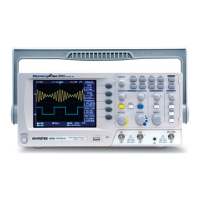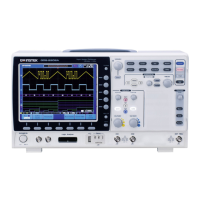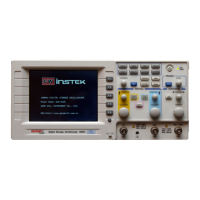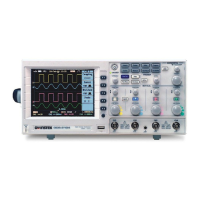CONFIGURATION
81
4. Press Mode repeatedly to
select the trigger mode,
Auto or Normal. To select
the Single trigger mode,
press the Single key.
Range
Auto, Normal
5. Press When repeatedly to
select the pulse condition.
Then use the Variable knob
to set the pulse width.
Condition
> , < , = , ≠
Width
20ns ~ 10s
6. Press Slope/Coupling to set
trigger slope and coupling.
7. Press Slope repeatedly to
select the trigger slope,
which also appears at the
bottom of the display.
Range
Rising edge, falling edge
8. Press Coupling repeatedly to
select the trigger coupling.
Range
DC, AC
9. Press Rejection to select the
frequency rejection mode.
Range
LF, HF, Off
GDS-1000A Series User Manual
82
10. Press Noise Rej to turn the
noise rejection on or off.
Range
On, Off
11. Press Previous menu to go
back to the previous menu.
Manually triggering the signal
Note: This section describes how to manually
trigger the input signals when the oscilloscope
does not capture them. This section applies to the
Normal and Single trigger mode, since in the Auto
trigger mode, the oscilloscope keeps updating the
input signal regardless of the trigger conditions.
To acquire the
signal regardless
of trigger
conditions
To acquire the input signal
regardless of the trigger
condition, press the Force key.
The oscilloscope captures the
signals once.
FORCE
In the Single
trigger mode
Press the Single key to start
waiting for the trigger
condition. To break out of the
Single mode, press the
Run/Stop key. The trigger
mode changes to the Normal
mode.
SINGLE
Run/Stop
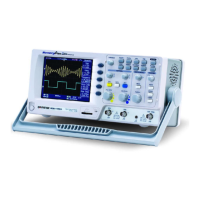
